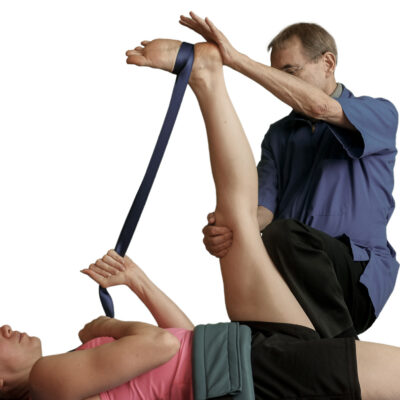No matter what their underlying health conditions are, most clients experience significant improvement from a method known as Active Assisted Stretching or AAS, which is by far the most efficient and effective stretching system I’ve ever encountered. In addition to rapidly increasing flexibility, it can also help speed recovery from a wide variety of pains and injuries. AAS has proven effective in helping elderly people regain their coordination, fine motor skills, and full range of motion, as well as helping athletes achieve maximum performance. AAS helps individuals with Parkinson’s, multiple sclerosis, muscular dystrophy, ALS, and other diseases by slowing the progression of debilitating neuromuscular symptoms.
How It Works
Recent research has shown that prolonged stretching can be counterproductive when trying to increase flexibility. Active Assisted stretches are held for no more than two seconds to maximize flexibility without harming the tissues and are repeated five to ten times. The practitioner provides just enough assistance to push slightly beyond what you could do on your own, without causing strain. The results are often dramatic, and the range of motion often increases quickly. Once you learn the stretches, you can do many of them on your own.
Benefits of Active Assisted Stretching include:
- Healthier muscles, fascia, tendons, ligaments, and joints
- Increased flexibility, strength, and range of motion
- Breakdown of adhesions caused by trauma or inflammation
- Reduced risk of muscle spasms, strains, and tears
- Improved circulation, which promotes tissue growth and repair
- Improved drainage of lymph, which helps eliminate waste
Why Try Active Assisted Stretching?
AAS speeds the healing of muscles, tendons, ligaments, fascia, and joints. Increasing flexibility and resilience can also greatly reduce an individual’s vulnerability to future injuries.
As we grow older, many of us accept limitations to our body’s functioning (such as a reduced range of motion, decreased strength and flexibility, and impaired coordination or fine motor skills) as an inevitable result of aging. Through AAS, many of these declines can be successfully prevented or reversed. You can feel younger and healthier. Restoring optimal health in areas of the body that have been injured, neglected, or overstressed can have profound effects on a person’s well-being and quality of life.
I can attest to this from personal experience; within a few months of trying AAS, I felt about 15 years younger. I have greater flexibility now than I can ever remember having before, and I continue to feel stronger and healthier as time goes by. I am grateful for the opportunity to share these same remarkable benefits with my clients.






